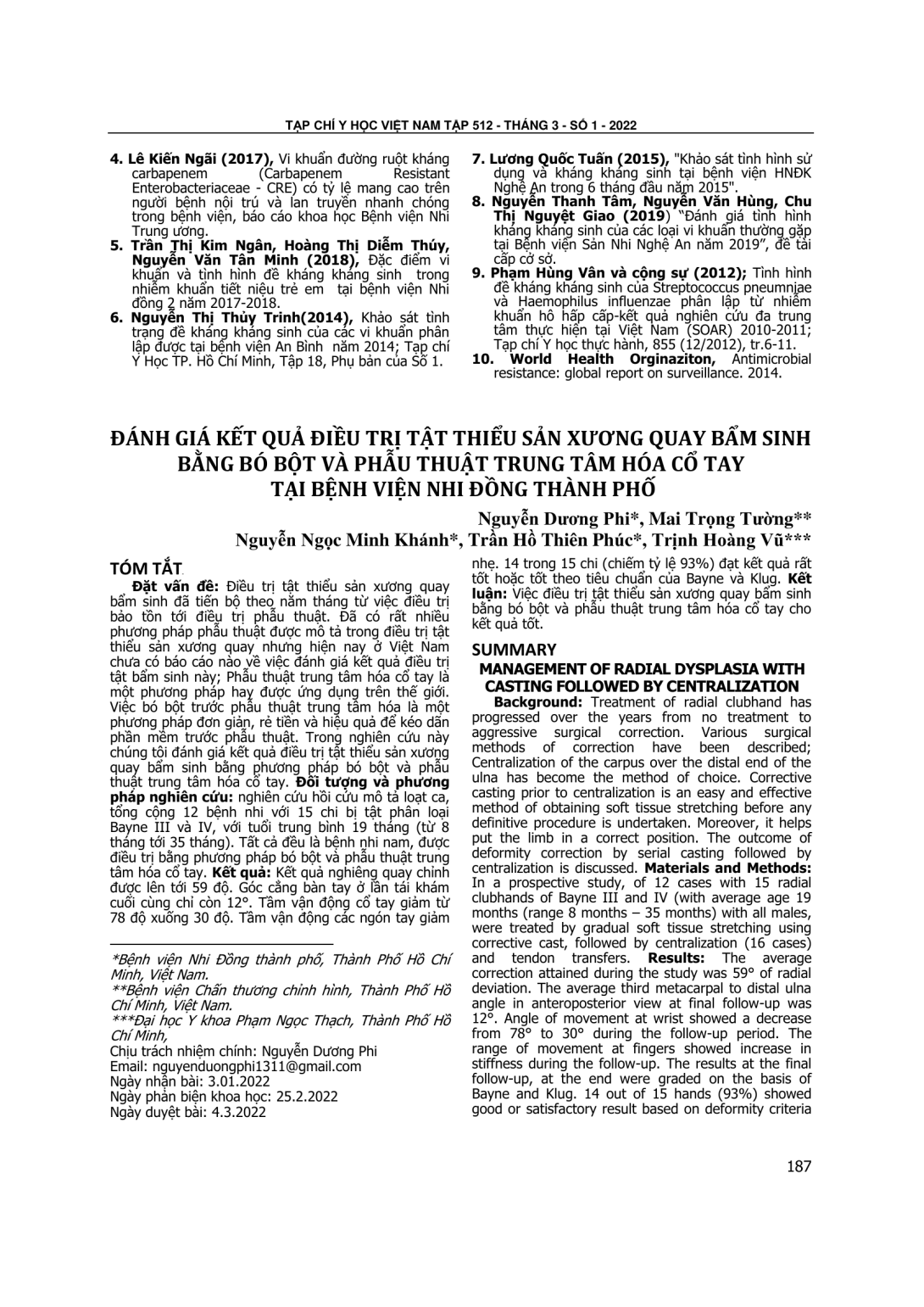
Điều trị tật thiểu sản xương quay bẩm sinh đã tiến bộ theo năm tháng từ việc điều trị bảo tồn tới điều trị phẫu thuật. Đã có rất nhiều phương pháp phẫu thuật được mô tả trong điều trị tật thiểu sản xương quay nhưng hiện nay ở Việt Nam chưa có báo cáo nào về việc đánh giá kết quả điều trị tật bẩm sinh này; Phẫu thuật trung tâm hóa cổ tay là một phương pháp hay được ứng dụng trên thế giới. Việc bó bột trước phẫu thuật trung tâm hóa là một phương pháp đơn giản, rẻ tiền và hiệu quả để kéo dãn phần mềm trước phẫu thuật. Trong nghiên cứu này chúng tôi đánh giá kết quả điều trị tật thiểu sản xương quay bẩm sinh bằng phương pháp bó bột và phẫu thuật trung tâm hóa cổ tay. Đối tượng và phương pháp nghiên cứu: nghiên cứu hồi cứu mô tả loạt ca, tổng cộng 12 bệnh nhi với 15 chi bị tật phân loại Bayne III và IV, với tuổi trung bình 19 tháng (từ 8 tháng tới 35 tháng). Tất cả đều là bệnh nhi nam, được điều trị bằng phương pháp bó bột và phẫu thuật trung tâm hóa cổ tay. Kết quả: Kết quả nghiêng quay chỉnh được lên tới 59 độ. Góc cẳng bàn tay ở lần tái khám cuối cùng chỉ còn 12°. Tầm vận động cổ tay giảm từ 78 độ xuống 30 độ. Tầm vận động các ngón tay giảm nhẹ. 14 trong 15 chi (chiếm tỷ lệ 93%) đạt kết quả rất tốt hoặc tốt theo tiêu chuẩn của Bayne và Klug. Kết luận: Việc điều trị tật thiểu sản xương quay bẩm sinh bằng bó bột và phẫu thuật trung tâm hóa cổ tay cho kết quả tốt.
Treatment of radial clubhand has progressed over the years from no treatment to aggressive surgical correction. Various surgical methods of correction have been described; Centralization of the carpus over the distal end of the ulna has become the method of choice. Corrective casting prior to centralization is an easy and effective method of obtaining soft tissue stretching before any definitive procedure is undertaken. Moreover, it helps put the limb in a correct position. The outcome of deformity correction by serial casting followed by centralization is discussed. Materials and Methods: In a prospective study, of 12 cases with 15 radial clubhands of Bayne III and IV (with average age 19 months (range 8 months – 35 months) with all males, were treated by gradual soft tissue stretching using corrective cast, followed by centralization (16 cases) and tendon transfers. Results: The average correction attained during the study was 59° of radial deviation. The average third metacarpal to distal ulna angle in anteroposterior view at final follow-up was 12°. Angle of movement at wrist showed a decrease from 78° to 30° during the follow-up period. The range of movement at fingers showed increase in stiffness during the follow-up. The results at the final follow-up, at the end were graded on the basis of Bayne and Klug. 14 out of 15 hands (93%) showed good or satisfactory result based on deformity criteria of Bayne and Klug. Conclusion: The management of radial clubhand by gradual corrective cast followed by centralization and tendon transfers in children is an acceptable method of treatment with consistently satisfactory results.
- Đăng nhập để gửi ý kiến
